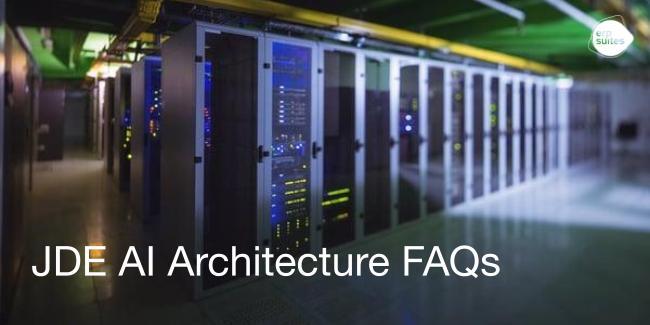Should You Migrate to Cloud Inventory’s New Cloud Platform?
February 12th, 2025
4 min read
.png?width=650&height=325&name=Blog%20Images%202_1%20(4).png)
As a JD Edwards user, you have several options in the marketplace for your barcode scanning needs. Many users rely on Cloud Inventory, which was bought by Nextworld in 2022. Nextworld recently announced they want Cloud Inventory users to upgrade to their cloud-based platform for barcode scanning.
It’s a big change, no matter how you slice it, and you’re not sure if it’s in your best interest or theirs. A decision like this can impact your business operations, budget, and future.
At ERP Suites, we know what that’s like for our customers. We’ve helped many make the switch from their existing barcode scanning solution to Scanability, our marketplace solution. We have the industry expertise and resources to make any barcode scanning transition easier for users.
Our sales team has been in conversation with existing NextWorld customers and in JDE user groups. We’ve heard that customers are unhappy, and we want to help you make the best decision for your company.
We’ll walk you through the pros and cons of upgrading to Nextworld’s new licensure to continue using Cloud Inventory versus considering alternatives like ERP Suites’ Scanability.
By the end, you’ll have a clearer picture of what’s right for you and your business.
Why Is Cloud Inventory Pushing This Upgrade?
Nextworld, a cloud-based ERP company founded by one of JD Edwards’ original creators, acquired Cloud Inventory (formerly known as DSI). Their goal is clear: they want to streamline their operations by moving everyone onto their cloud platform. It makes sense for them—it’s cheaper to support one platform rather than several different versions of software.
To sweeten the deal for existing users, they’re offering incentives like free migration and the promise of an easier-to-use, low-code/no-code development platform. This means that theoretically, you don’t need to be a developer to create or modify workflows. If making quick changes without diving into complex code is appealing, this is a plus.
However, there are some real drawbacks worth considering. Users switch solutions or stay with existing solutions for a variety of reasons.
The most important boil down to:
- Licensing – How are you paying for your solution?
- Location – Does your solution reside on premises or in the cloud?
- Longevity – Is your solution going to be around for the long haul?
A New Licensing Model Means You Could Lose Your Investment
One of the primary changes introduced by Nextworld is moving from perpetual software licenses to a rental model. This can make customers who have already invested in license purchases feel shortchanged.
Pro: Staying Aligned with Nextworld’s Changes
Your perpetual license loss is a reality if you stay with Nextworld. There’s no way around it. But staying with Nextworld and accepting the licensing adjustments means you’d remain aligned with the company and their new direction.
Con: Losing Your Investment in Perpetual Licenses
If you previously bought a perpetual license for Cloud Inventory, upgrading to Nextworld’s licensure model means switching to a subscription (rental) model. In simple terms: the investment you made is gone.
With licensing models, your costs come from the initial purchase and added support fees. Let’s say a typical barcode scanning solution license costs $200,000. Annual support is 20% of the license cost for a total of $40,000 per year. Over three years, you’d pay $200,000 + (3 x $40,000) = $320,000.
If you switch models, you now must pay both ongoing subscription fees and support fees to continue using the same software. That can be a tough pill to swallow after already investing $200,000 to “buy” the software.
Alternative: A Hybrid Model
Other barcode scanning solutions can help you avoid this situation altogether. Take Scanability, for example. Its model is something of a subscription hybrid, offering three different tiers with different amounts of users for each . You’re not paying for anything you don’t need, and you’ll have access to any investments you’ve made with us.
Cloud-Based Solutions: Pros and Cons
Using the cloud can make many functions easier. There’s less hardware involved onsite, and upgrades can be easier. There are also several weaknesses – latency issues, dependency on internet connectivity, data privacy and compliance, and recurrent storage fees, just to name a few.
Pro: Cloud-Based Convenience
With the new platform being cloud-based, you could reduce the hardware you need on-site. This can mean fewer servers to maintain, lower power costs, and potentially easier upgrades since they happen on the cloud provider’s end.
If you’re looking to modernize and minimize your on-premises infrastructure, this could be appealing.
Con: Cloud Connectivity Issues
A cloud-based solution means your barcode scanning depends on a reliable internet connection. If that connection goes down—due to a fiber line cut, a network outage, or even a glitch—you can’t scan. For warehouse operations, even a few minutes of downtime can lead to chaos. Orders get delayed, productivity grinds to a halt, and you’re left at the mercy of factors outside your control.
Your autonomy to decide whether to take upgrades is also eliminated. If you use cloud-based software, you have to do what that provider dictates.
Alternative: An On-Site Solution Means 24/7 Connectivity
Scanability runs within your own four walls. That means that even if catastrophe is striking the internet on a particularly busy day, your warehouse operations will continue without a hitch. Scanability does not have store and forward functionality, which Cloud Inventory does, so that can be a drawback for some.
Risks of Moving Away from an Oracle Focus for JD Edwards Users
JD Edwards has been around a long time. Thousands of companies around the world still use it, and Oracle keeps supporting it. As such, moving away from the Oracle world to any degree can feel quite risky.
Pro: Future ERP Integration
If you’re interested in moving away from the Oracle ecosystem, Nextworld’s new platform could be your solution. This upgrade could be a steppingstone to that end game. It might also feel that staying with Nextworld is less risky. After all, you’re keeping things familiar.
Con: Divergence is Destabilizing
For folks who aren’t ready to make the switch, this move could make them feel isolated. What happens if Nextworld decides to phase out Cloud Inventory entirely? Their R&D efforts are likely going to be focused on their ERP, not enhancing Cloud Inventory. And integrating their new solution with JDE might require custom work, adding cost and complexity.
Alternative: All in on JDE
Scanability is all in on JD Edwards. Its functionality is possible through Orchestrations, which are built into JDE. Without JDE, there is no Scanability. As such, this means your investment in Oracle continues to work for you, because we continue to make Scanability a better and stronger solution.
Make These Key Considerations Before Making the Switch
Upgrading to Nextworld’s new licensure might seem like the path of least resistance, but it’s essential to weigh the pros and cons carefully. Be sure you:
- Consider the total cost of upgrading: licensing fees, migration costs, training, and potential downtime.
- Ask yourself: Do you want a solution that supports JD Edwards long-term, or are you willing to risk being nudged toward a new ERP platform?
- How will a cloud-based solution affect your daily operations, especially in terms of connectivity and control over upgrades?
If you’re interested in exploring other barcode scanning solutions, this article outlines how Scanability, Cloud Inventory, and RF Smart compare to each other.
Leyla Shokoohe is an award-winning journalist with over a decade of experience, specializing in workplace and journalistic storytelling and marketing. As content manager at ERP Suites, she writes articles that help customers understand every step of their individual ERP journey.
Topics:



.png?width=650&height=325&name=Blog%20Images%202_1%20(5).png)
.png?width=650&height=325&name=Blog%20Images%202_1%20(3).png)
.png?width=650&height=325&name=Blog%20Images%202_1%20(2).png)
.png?width=650&height=325&name=Blog%20Images%202_1%20(1).png)
.png?width=960&height=540&name=Blog%20Images%20(96).png)

.png?width=960&height=540&name=Blog%20Images%20(90).png)
.png?width=960&height=540&name=Blog%20Images%20(88).png)
.png?width=960&height=540&name=Blog%20Images%20(87).png)
.png?width=960&height=540&name=Blog%20Images%20(86).png)
.png?width=960&height=540&name=Blog%20Images%20(85).png)
.png?width=960&height=540&name=Blog%20Images%20(83).png)
.png?width=960&height=540&name=Blog%20Images%20(82).png)
.png?width=960&height=540&name=Blog%20Images%20(80).png)
.png?width=960&height=540&name=Blog%20Images%20(79).png)
.png?width=960&height=540&name=Blog%20Images%20(78).png)